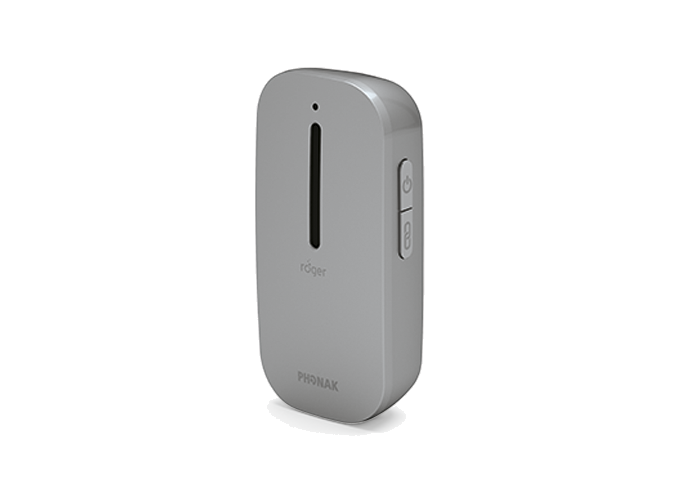
FAQs

Q: Are all hearing aids / cochlear implants compatible with Roger Clip-On-Mic?
A: Yes. With three categories of Roger receivers available, there is a solution for virtually every listener, regardless of the hearing technology your client uses.
- Design-integrated receivers are avialble for Phonak hearing aids and selected CI sound processors.
- The miniature universal Roger X receiver can be attached to an audio shoe or streamer regardless of the manufacturer.
- The universal neckloop receiver Roger MyLink is compatible with any hearing aid or CI sound processor that has a T-Coil.
You can also use our Roger Configurator tool (English only) to match hearing aids/CIs with the right Roger receivers.
Q: What is the difference of Roger Clip-On Mic compared to the Roger Pen/Roger EasyPen?
A: The Roger Clip-On Mic is dedicated for a single conversation partner, whereas Roger Pen and Roger EasyPen are made for listening to multiple speakers and cover more use cases.
Q: What is the operating range of Roger Clip-On Mic?
A: The typical operating range is 10 meters / 33 feet. If the Roger microphone and receivers are in direct line of sight, then the range may be up to 20 meters / 66ft.*
*Range may be impacted by the 2.4GHz technology, which cannot travel through human bodies or other obstacles.
Q: When my customer uses a Roger system, are other people able to ‘listen in’ on his conversation?
A: No, the transmission is secure. Only receievrs connected to the Roger microphone can receive the signal.
Q: What should a customer do to understand better in a noisy environment with a Roger microphone?
A:
- Ask the speaker to place the microphone closer to his/her mouth.
- Make sure the top of the microphone is pointing towards the mouth.
- When using Roger Pen, the customer might want to consider changing its microphone mode by overriding the automatic setting. The most effective microphone setting in heavy noise is setting 3 (press the Roger Pen’s microphone button three times to access this).
Q: How can the volume of the Roger signal be adjusted when watching TV?
A: The volume of the TV’s audio output can usually be adjusted with the TV’s own volume control. Check also the TV’s settings to see whether the volume of its speakers and its audio output can be adjusted separately.
Note: If the customer has a separate TV-box, it is recommended that they should connect the docking station to this box’s audio output. This way the customer can set the volume of the TV-box (the Roger signal you hear) to one level, but the TV’s normal output (via its speakers) to another level that suits other listeners.
Q: How can the docking station be connected to a TV?
A: The easiest way is to connect the audio cable to the TV’s headphone output and additionally to the docking station’s audio input. As this may mute the TV’s speakers, there are other options to pick up the TV’s signal:
- Use the TV’s SCART or Cinch analog output (such adapters are available at electronic stores or can be purchased from Phonak).
- Use any analog audio output of the TV-box.
- Use the TV’s or TV-box’s Optical Toslink or Coaxial (RCA) digital audio output and a converter. Such digital to analog audio converters are available at electronic stores or can be purchased from Phonak.
Q: How can the volume of the Roger microphone be adjusted?
A: The volume of the microphone cannot be adjusted. However the default volume of selected Roger receivers (option (02)) can be adjusted using a Roger inspiro. Please refer to the user guide of Roger inspiro to change the default volume of the receiver.
Alternatively, adjusting the volume of the hearing aid will also change the volume of the Roger microphone.
Q: Can a Roger microphone be used to listen to GPS navigation?
A: Yes. Simply use the micro-USB audio cable supplied to connect the GPS’ headphone output to the Roger microphone. Then switch on the Roger microphone and the GPS navigation. The Roger microphone will switch to audio mode as soon as it detects audio coming from the GPS. This will mute Roger’s microphones so that your customer can fully concentrate on the GPS’ directions.
Q: How can my customer use my Roger microphone to talk on the phone?
A: Roger Pen can be directly paired with any Bluetooth® enabled phone.
There are other options available for phones without Bluetooth. Please check the Guidebook for further details.
Q: Is it possible to listen to more than one Roger microphone at once?
A:Yes, up to 10 microphones can be connected to a Roger network.
The device on which ‘Connect’ is pressed to add additional microphones will become the controller of the network and needs to be available to use other microphones.
Only one microphone will be active at a time, meaning the first speaker will be heard. If another speaker talks at the same time, he/she will not be heard until the initial speaker stops speaking.
Roger Technology FAQs
Q: What is Roger?
A: Roger is the new digital standard that bridges the understanding gap, in noise and over distance, by wirelessly transmitting the speaker’s voice directly to the listener.
Q: Who can benefit from Roger?
A: People with hearing loss who struggle to hear and understand speech in challenging listening situations, such as in loud noise and over distance, even when wearing hearing aids or cochlear implants.
Q: Why is it called Roger?
A: The name Roger comes from the aviation/radio world, where it means “message received and understood.”
Q: Are digital hearing aids not enough?
A: Some digital hearing aid users feel that because their sound quality has improved and background noise has been reduced, they no longer need the help of a personal wireless microphone system.
However, a Roger system still offers many advantages over digital hearing aids alone. These include reducing the effects of reverberation (echo) and helping to overcome the effects of distance between the speaker and the hearing-impaired listener.
Q: If my customer wears two hearing aids, should he/she wear two Roger receivers?
A: Yes, because scientific evidence shows that transmitting speech to both ears brings the greatest benefit. One study proved that speech understanding improved by 40% when two wireless receivers were used instead of one.
(Valente, Enrietto, Crandell, Lewis [2002]).
Q: At what age should a child start using Roger technology?
A: Wireless microphone technology can play a valuable role in boosting a child’s access to sound from an early age, which is crucial for their speech and language development. Most experts recommend introducing such systems once a child becomes mobile.
Q: What does Roger technology offer?
A:
- Roger uses 100% digital transmission.
- Roger connects devices (receivers, additional microphones) to a network with just one click.
- Roger operates on the 2.4 GHz band, which is globally license-free, allowing clients to travel and use their systems around the world.
- Thanks to its intelligent, adaptive algorithms, Roger’s signal is immune to electromagnetic interference.
- Roger technology finally allows adult users to better hear the words of multiple microphone users. Research by L. Thibodeau (2013, 2014) shows that over distance in 75dB(A) noise, hearing aid users with a Roger system understand speech better than people without hearing loss by 62 percentage points.
- Roger eliminates frequency management – professionals such as teachers and educational audiologists no longer need to manage channels.
Q: How is Roger technology different than Bluetooth® technology?
A: Roger is an adaptive digital wireless transmission technology standard developed by Phonak, which runs on the 2.4 GHz band.
Roger features:
- Low delay for effective face-to-face communication.
- Reliable long-range broadcast towards miniature, low-power receivers.
While Bluetooth operates on the same frequency band as Roger, it uses a different protocol and is therefore not compatible. It also differs in the following additional ways:
- Bluetooth technology consumes significantly more power than Roger at the receiver level.
- The number of Bluetooth receivers (e.g. headphones or handsfree kit) is limited to three, whereas a Roger system allows broadcasting to an unlimited number of receivers.
- The audio delay of a Bluetooth system is much higher than that of a Roger system.
Q: Are Roger networks affected by solar panels?
A: No. Roger is a robust digital wireless standard that is immune to such possible causes of interference.
Q: Are Roger networks affected by Wi-Fi networks?
A: A Roger network cannot be affected by Wi-Fi. This means surfing on the internet while using a Roger system does not impact the audio signal at all.
However, Wi-Fi networks are not that robust and the Wi-Fi can temporarily be reduced if a Roger microphone is closer than 1m / 3feet to an 802.11g Wi-Fi access point.
Q: Can my customer use a Roger system on an airplane?
A: Since Roger is a radio system that features both transmitter (microphone) and receiver units, it faces the same in-flight restrictions as cell phone technology. Consequently, it should not be used on a plane.
Q: Can my customer use a Roger system in a hospital?
A: The output power of Roger wireless microphones is very low and falls well within all government-established safety standards.
That said, although you should be able to use a Roger system in a hospital, we recommend you do not use it in an Intensive Care Unit or Operating Theater.
Q: Will a Roger system affect a pacemaker?
A: To our knowledge there have not been any reported cases of wireless microphone systems for people with hearing loss affecting pacemakers or other medical devices. However, people with pacemakers or other medical devices should always consult their physician or the manufacturer of their device before using a Roger device. The use of the device with a pacemaker or with other medical devices should always be in accordance with the safety recommendations of the physician responsible for your pacemaker or the pacemaker manufacturer.
Roger products are in compliance with the essential requirements and other relevant provisions of Directive 1999/5/EC. Additionally, all Roger accessories for hearing aids comply with the essential requirements and other relevant provisions of Directive 93/42/EEC (Medical Devices Directive).
